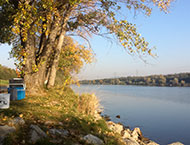The impact of Giardia spp. as a reference pathogen in urban water systems
Project funded by the Wiener Wissenschafts-, Forschungs- und Technologiefonds (WWTF)
Call Environmental Systems Research 2017 - Urban Environments / ESR17-070
Principal Investigator
Sílvia Cervero-Aragó
Institution
Medical University of Vienna
Collaborator
Julia Derx (Vienna University of Technology) (Co-PI)
Further collaborators
Julia Walochnik (Medical University of Vienna)
Alfred Paul Blaschke (Vienna University of Technology)
Hatice Seda Kilic (Vienna University of Technology)
Gerhard Lindner (Vienna University of Technology, Medical University of Vienna)
Rita Linke (Vienna University of Technology)
Andreas Farnleitner (Vienna University of Technology, Karl Landsteiner University Krems)
Alexander Kirschner (Medical University of Vienna, Karl Landsteiner University Krems)
Regina Sommer (Medical University of Vienna)
Jack Schijven (Utrecht University, The Netherlands)
Status
Ongoing (01.01.2018 – 31.12.2021) 48 months
Project summary
As urban populations grow the quality of the urban environment plays an increasingly important role in public health. In urban settings, waterborne pathogens can be transmitted via wastewater, sewer overflows or leaking sewers as well as via cross-contamination from animals to humans through direct or indirect transmission routes. The aim of the current project is to develop a cutting-edge predictive urban water quality model combined with monitoring data for wise-city planning for the future [1].
Following a holistic approach an interdisciplinary team of researchers will investigate the potential sources and flow paths of waterborne pathogens and associated health impacts in an urban system during recreational and drinking water usage. The water transmissible pathogen Giardia will be used as reference pathogen.
In a monitoring campaign the microbiological water quality of wastewater and urban rivers and surface water bodies (surface waters) will be investigated at multiple levels including Giardia and the prevalence of its different genotypes, as well as host-associated genetic fecal markers (microbial source tracking, MST) and standard fecal indicators (SFI). As urban study area, the wastewater impacted River Danube and the urban tributaries of the city of Vienna have been selected. The study area includes several important recreational sites used for bathing or water sports (e.g. Danube Island, Old Danube, Lower Lobau [2]).
These sites are also frequented by domesticated animals and urban wildlife. The sampling data obtained at multiple levels will flow into a recently developed hydrological water quality model QMRAcatch [3,4] which will be newly adapted to predict Giardia concentrations in the urban surface waters of Vienna and different potential exposure routes.
After calibration, the model will be used to investigate the pathogen infection risks associated with recreational use and the required pathogen reduction for drinking water production (riverbank filtration) based on health targets for the status quo and possible future scenarios. This will further contribute in assessing robust protection measures and water treatment criteria considering possible future scenarios like climate change, changes in management strategies, migration and urbanization, considered to be of high social relevance.
[1] International Water Association: The IWA principles for water wise cities - for urban stakeholders to develop a shared vision and act towards sustainable urban water in resilient and liveable cities. In: http://www.iwa-network.org/projects/water-wise-cities/#the_17_iwa_principles_for_water-wise_cities, 2017
[2] Frick C, Zoufal W, Zoufal-Hruza C, Kirschner AKT, Seidl D, Derx J, et al.: The microbiological water quality of Vienna’s River Danube section and its associated water bodies. Österr. Wasser- und Abfallwirtschaft, 2016
[3] Schijven J, Derx J, Husman AMD, Blaschke AP, Farnleitner AH.: QMRAcatch: Microbial Quality Simulation of Water Resources including Infection Risk Assessment. J Environ Qual. 2015;44: 1491–1502
[4] Derx J, Schijven J, Sommer R, Zoufal-Hruza CM, van Driezum IH, Reischer G, et al.: QMRAcatch: Human-associated fecal pollution and infection risk modeling for a river/floodplain environment. J Environ Qual. 2016;45.

